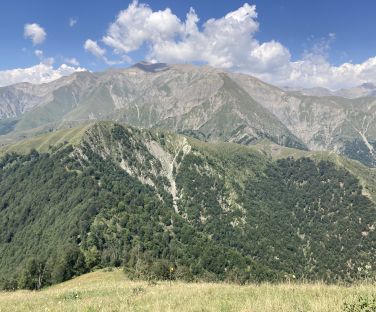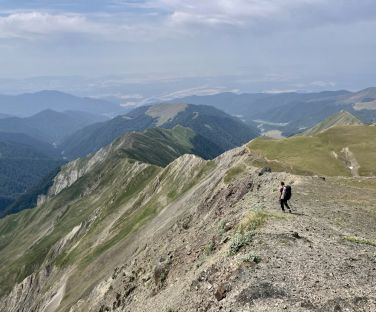
Nazrin Garibova
Nazrin was born in Azerbaijan in 1998 and grew up in America. She joined the Transcaucasian Trail project in 2020.
Last summer of 2021, I headed to the northern mountains of Azerbaijan with a local friend in search of existing and potential hiking trails. This endeavour was taken up to scout for a larger project called the Transcaucasian Trail. The final east-west route of this long-distance hiking trail will span from Batumi all the way to the Caspian coast near Baku. However, this journey provided much more than GPS tracks and culminated in an unforgettable experience that, for me, put Azerbaijan in an entirely new light and perspective.
Needless to say, the landscapes were incredible. The terrain rapidly changed, and each new view would take my breath away. In the east around Siyazan, there’s a semi-desert climate with foothills and low mountains, and colourfully striated, fascinating rock formations. We moved into Guba and Gusar and were met with rushing rivers, cascading waterfalls, saturated fields of wildflowers, all decorating the unbelievable canyons striped with lines of trees along the mountains’ walls. Crossing into the southside of the Greater Caucasus, we landed in Ismayilli and Gabala. The scenery drastically changed into green, lusciously forested mountains. One can find poplars, beeches, oaks, maples, chestnut and hazelnut trees… Not to mention the plethora of blackberries, each waiting to be picked and enjoyed in its juicy, flavourful glory. These forested mountains continued all the way up to Balaken, but the trek there offered a variety of views and experiences.
While traversing the Greater Caucasus, we were granted incredible opportunities to learn about the local cultures. Azerbaijan, like the Caucasus as a whole, is an abundantly diverse place. In the northern region (namely, Guba and Gusar), remain many of the ethno-linguistic groups that Strabo had recorded as some of the 26 Caucasian Albanian tribes. Many villages are unique in their language, enigmatic in their history. Several are home to their own ethno-linguistic groups, including the Ketch, Lezgi, Griz, and Avar people. In the small village of Gümürdəhnə, we met some Tat families, who were perhaps the most warm and welcoming people I’ve ever met (even by high Azerbaijani standards!).
For the most part, we stayed in tents, but at times the hospitality of the people in certain villages was impossible to turn down. Many families in these areas have opened their homes as guesthouses. Along with bottomless samovar tea and delicious, home-cooked traditional food, a visitor gets the opportunity to learn about the village’s histories, folklore, and way of life from gracious hosts. A lot of the trail-scouting progress can be attributed to the people living with the mountains, who were eager to share their knowledge and insights about the routes and terrain.
Last summer marked the first stage of the Transcaucasian Trail in Azerbaijan, and what a remarkable first step it was! I await in great anticipation of what the coming years hold in preparing a spectacularly immersive, picturesque, diverse hiking experience along the mountains of Azerbaijan.
Travel dates: June-September 2021
Traveled regions: Siyazan, Shabran, Guba, Gusar, Ismayilli, Gabala, Oghuz, Shaki, Gakh, Zagatala







